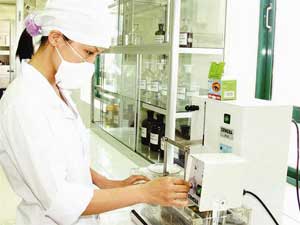With the newly issued decree from the government, from now on, scientific and technological institutions “will wear two hats”. Scientists are granted a range of rights, including the right to earn unlimited income.
 Research units can operate as legitimate businesses; they have the right to produce and trade from A to Z, even having the right to import and export directly.
Research units can operate as legitimate businesses; they have the right to produce and trade from A to Z, even having the right to import and export directly.
It has taken 10 years since the Central Committee’s Resolution 2 regarding new policies for science and education, and perhaps now is the time public scientists (abbreviated as public scientists) truly feel the winds of change.
At a meeting in Hanoi on November 10, 2005, Dr. Nguyen Quan, Head of the Organization and Personnel Department of the Ministry of Science and Technology (S&T), metaphorically stated that with the newly issued Decree No. 115/2005/ND-CP, public scientific and technological institutions “will wear two hats” from now on.
In addition to the first hat, which still represents them as scientific research entities as before, for the first time, they can don the second hat, being recognized and operating as legitimate businesses.
As businesses, public scientific and technological organizations now have a plethora of new rights. Instead of only being allowed to conduct trial production of products from research projects, they now have the right to produce from A to Z. Moreover, they also have the right to produce and trade all items that are not prohibited by law, and even have the right to import and export directly.
Thanks to donning the second hat, heads of public scientific and technological organizations gain unprecedented rights concerning personnel and finance. Regarding personnel, heads now have the authority to decide the entire staffing of their organizations, appoint, dismiss, assign, retire, terminate employment contracts, reward, and discipline all positions within their organization.
|
– Heads of units have the right to “directly decide to invite experts and foreign scientists to Vietnam and send staff abroad for work,” Subsection b, Clause 4, Article 5, Section 1, Chapter II, Decree No. 115/2005/ND-CP dated September 5, 2005. – In response to a question from a reporter of Tien Phong newspaper, Dr. Nguyen Quan stated, “Scientific organizations are understood to encompass both natural sciences and social sciences. According to the new decree, scientific units after the transformation have the right to independently establish their scientific research projects, even if they are in opposition to state projects. These units even have the right to organize research projects about Long An independently of the research projects assigned by the Vietnam Institute of Science and Technology.” |
“Implementing this regulation will put an end to the long-standing issue where many individuals remain complacent in their positions until retirement, regardless of their poor performance or laziness,” said Dr. Le Dinh Tien, Deputy Minister of Science and Technology.
The only limitation regarding personnel is that the position of deputy in the organization still requires the approval of the higher-level management authority. “This restriction is to prevent the risk of the heads of units abusing their power to appoint their acquaintances to key positions within the organization,” explained Dr. Nguyen Quan – however, we still aim to propose the removal of this final limitation by 2010.
Regarding assets, most of the state assets will be transferred to the unit as a “dowry” before they “live independently.” Accordingly, public scientific and technological organizations have the right to auction and mortgage these assets. Especially, intangible assets such as intellectual property rights, inventions, and patents will also be used in business and valued in the market like any other goods.
Perhaps the most attractive aspect is regarding income. After deducting all obligations, the remaining profit of public scientific and technological organizations will be distributed among members without any limit on the maximum amount.
In the operation of public scientific and technological organizations, they will continue to receive budget funding from the state. The difference is that the budget will not be allocated based on the staffing quotas often referred to by scientists as “black heads,” but rather according to assigned tasks. This initial “fuel” input is significant for these organizations as they embark on the market for the first time.
The Kite Must Have a String
To mitigate the risk of potential “dictatorship” from heads, as some concerns were raised at the meeting, Mr. Nguyen Son from the Ministry of Home Affairs stated that guidelines will be included in a circular to be completed by the end of December this year, requiring public opinion on key personnel decisions.
Furthermore, to prevent the risk of all state assets being “burned” in unprofitable business ventures, the decree imposes sanctions, mandating that a portion of the unit’s assets must be maintained to serve research tasks as assigned. Notably, key laboratories (worth tens of billions of VND) are not allowed to be auctioned or mortgaged.
However, some concerns are deemed excessive and heavily influenced by the subsidized mentality. Addressing worries that public scientific and technological organizations might neglect their research duties in pursuit of profit, Deputy Minister Le Dinh Tien stated that the decree clearly indicates that the state will continue to “nurture” basic research units. In the long run, as the economy develops, major enterprises will actually become the foundation for establishing applied research institutes, and even basic research, similar to what industrialized nations currently practice.
The call to action has been sounded. The troops are preparing to engage. To avoid a situation where plans are made but not executed, a specific roadmap has been completed and awaits approval. Of the 1,200 scientific and technological organizations nationwide, 560 are state-owned, also known as public organizations. About half of these public organizations will be subject to the regulations of Decree 115. Initially, approximately two-thirds of the regulated organizations will implement changes immediately.
To start with, 10 pilot organizations, representing 10 ministries and 5 provinces, will lead the way. According to the plan, by the end of 2006, a comprehensive inventory of assets will be completed, and specific plans will be established for these 10 units. Implementation will begin in 2007, with a summary by the end of 2008.
By the end of December 2009, all public scientific and technological organizations under the transformation scope must convert into one of two forms, either as self-financing scientific and technological organizations or as scientific and technological enterprises. Any units that fail to transform will be resolutely dissolved or merged.
Quoc Dung


















































